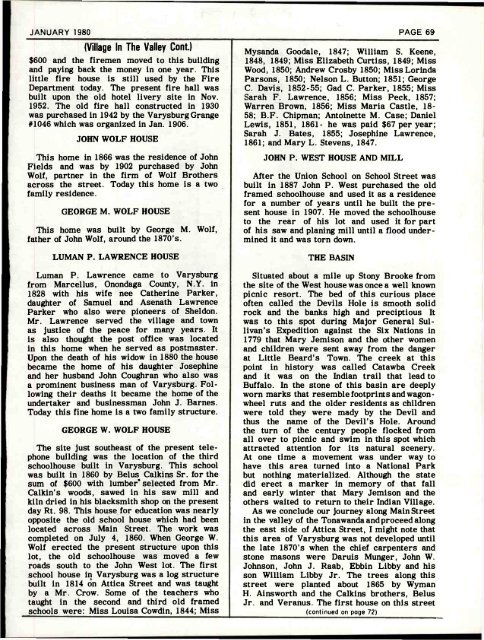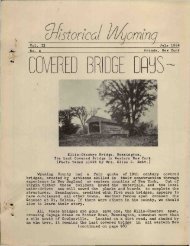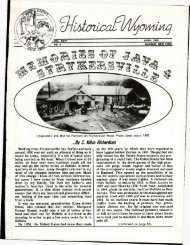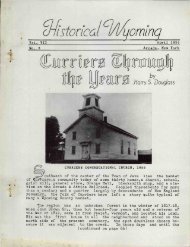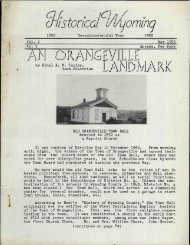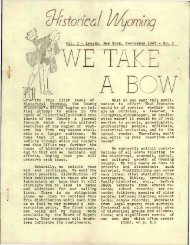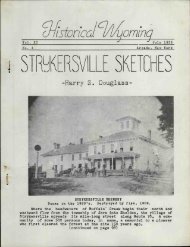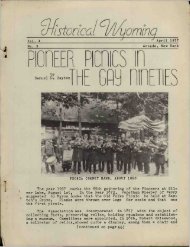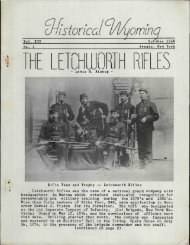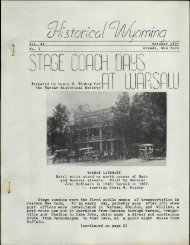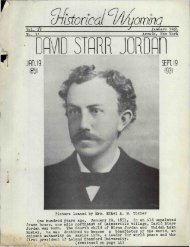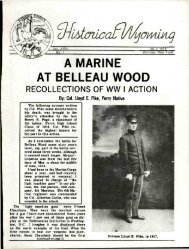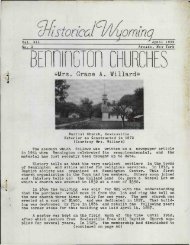Historical Wyoming County Jan 1980 - Old Fulton History
Historical Wyoming County Jan 1980 - Old Fulton History
Historical Wyoming County Jan 1980 - Old Fulton History
You also want an ePaper? Increase the reach of your titles
YUMPU automatically turns print PDFs into web optimized ePapers that Google loves.
JANUARY <strong>1980</strong> PAGE 69<br />
(Village In The Valley Cont.)<br />
$600 and the firemen moved to this building<br />
and paying back the money in one year. This<br />
little fire house is still used by the Fire<br />
Department today. The present fire hall was<br />
built upon the old hotel livery site in Nov.<br />
1952. The old fire hall constructed in 1930<br />
was purchased in 1942 by the Varysburg Grange<br />
#1046 which was organized in <strong>Jan</strong>. 1906.<br />
JOHN WOLF HOUSE<br />
This home in 1866 was the residence of John<br />
Fields and was by 1902 purchased by John<br />
Wolf, partner in the firm of Wolf Brothers<br />
across the street. Today this home is a two<br />
family residence.<br />
GEORGE M. WOLF HOUSE<br />
This home was built by George M. Wolf,<br />
father of John Wolf, around the 1870's.<br />
LUMAN P. LAWRENCE HOUSE<br />
Luman P. Lawrence came to Varysburg<br />
from Marcellus, Onondaga <strong>County</strong>, N.Y. in<br />
1828 with his wife nee Catherine Parker,<br />
daughter of Samuel and Asenath Lawrence<br />
Parker who also were pioneers of Sheldon.<br />
Mr. Lawrence served the village and town<br />
as justice of the peace for many years. It<br />
is also thought the post office was located<br />
in this home when he served as postmaster.<br />
Upon the death of his widow in 1880 the house<br />
became the home of his daughter Josephine<br />
and her husband John Coughran who also was<br />
a prominent business man of Varysburg. Following<br />
their deaths it became the home of the<br />
undertaker and businessman John J. Barnes.<br />
Today this fine home is a two family structure.<br />
GEORGE W. WOLF HOUSE<br />
The site just southeast of the present telephone<br />
building was the location of the third<br />
schoolhouse built in Varysburg. This school<br />
was built in 1860 by Belus Calkins Sr. for the<br />
sum of $600 with lumber* selected from Mr.<br />
Calkin's woods, sawed in his saw mill and<br />
kiln dried in his blacksmith shop on the present<br />
day Rt. 98. This house for education was nearly<br />
opposite the old school house which had been<br />
located across Main Street. The work was<br />
completed on July 4, 1860. When George W.<br />
Wolf erected the present structure upon this<br />
lot, the old schoolhouse was moved a few<br />
roads south to the John West lot. The first<br />
school house in Varysburg was a log structure<br />
built in 1814 on Attica Street and was taught<br />
by a Mr. Crow. Some of the teachers who<br />
taught in the second and third old framed<br />
schools were: Miss Louisa Cowdin, 1844; Miss<br />
Mysanda Goodale, 1847; William S. Keene,<br />
1848, 1849; Miss Elizabeth Curtiss, 1849; Miss<br />
Wood, 1850; Andrew Crosby 1850; Miss Lorinda<br />
Parsons, 1850; Nelson L. Button; 1851; George<br />
C. Davis, 1852-55; Gad C. Parker, 1855; Miss<br />
Sarah F. Lawrence, 1856; Miss Peck, 1857;<br />
Warren Brown, 1856; Miss Maria Castle, 18-<br />
58; B.F. Chipman; Antoinette M. Case; Daniel<br />
Lewis, 1851, 1861- he was paid $67 per year;<br />
Sarah J. Bates, 1855; Josephine Lawrence,<br />
1861; and Mary L. Stevens, 1847.<br />
JOHN P. WEST HOUSE AND MILL<br />
After the Union School on School Street was<br />
built in 1887 John P. West purchased the old<br />
framed schoolhouse and used it as a residence<br />
for a number of years until he built the present<br />
house in 1907. He moved the schoolhouse<br />
to the rear of his lot and used it for part<br />
of his saw and planing mill until a flood undermined<br />
it and was torn down.<br />
THE BASIN<br />
Situated about a mile up Stony Brooke from<br />
the site of the West house was once a well known<br />
picnic resort. The bed of this curious place<br />
often called the Devils Hole is smooth solid<br />
rock and the banks high and preciptious It<br />
was to this spot during Major General Sullivan's<br />
Expedition against the Six Nations in<br />
1779 that Mary Jemison and the other women<br />
and children were sent away from the danger<br />
at Little Beard's Town. The creek at this<br />
point in history was called Catawba Creek<br />
and it was on the Indian trail that lead to<br />
Buffalo. In the stone of this basin are deeply<br />
worn marks that resemble footprints and wagonwheel<br />
ruts and the older residents as children<br />
were told they were mady by the Devil and<br />
thus the name of the Devil's Hole. Around<br />
the turn of the century people flocked from<br />
all over to picnic and swim in this spot which<br />
attracted attention for its natural scenery.<br />
At one time a movement was under way to<br />
have this area turned into a National Park<br />
but nothing materialized. Although the state<br />
did erect a marker in memory of that fall<br />
and early winter that Mary Jemison and the<br />
others waited to return to their Indian Village.<br />
As we conclude our journey along Main Street<br />
in the valley of the Tonawanda and proceed along<br />
the east side of Attica Street, I might note that<br />
this area of Varysburg was not developed until<br />
the late 1870's when the chief carpenters and<br />
stone masons were Daruis Munger, John W.<br />
Johnson, John J. Raab, Ebbin Libby and his<br />
son William Libby Jr. The trees along this<br />
street were planted about 1865 by Wyman<br />
H. Ainsworth and the Calkins brothers, Belus<br />
Jr. and Veranus. The first house on this street<br />
(continued on page 72)


